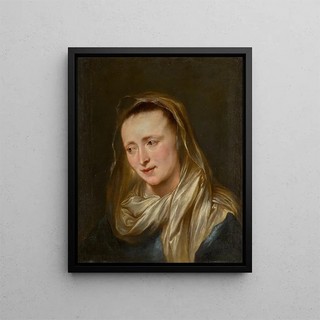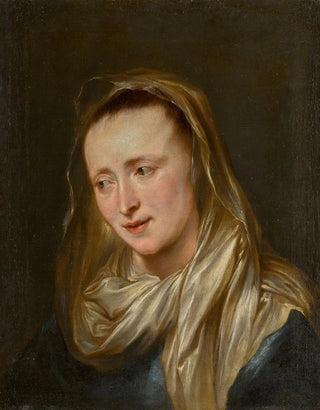Painting Head of a Woman Probably the Virgin - School of Antoine van Dyck


View from behind

Frame (optional)
Art print of a Head of a woman, probably the Virgin - School of Antoine van Dyck – Captivating introduction
The art print of a Head of a woman, probably the Virgin - School of Antoine van Dyck immerses us in a universe where spirituality and beauty intersect. This piece, emblematic of the Flemish School, evokes feelings of serenity and devotion. The depiction of the Virgin, a central figure of Christian faith, is imbued with a tenderness that transcends time. The delicate features of the face, the light dancing on the skin, and the peaceful expression of the female figure invite the viewer to a deep contemplation. In a world where sacred art is often associated with intense emotions, this work stands out for its grace and subtlety, capturing the very essence of divine femininity.
Style and uniqueness of the work
The style of this piece is characterized by remarkable finesse and meticulous attention to detail. Antoine van Dyck, master of portraiture, infused this representation with palpable humanity. The nuances of colors, ranging from warm tones to delicate shadows, create an intimate atmosphere that envelops the viewer. The composition is carefully balanced, highlighting the face of the Virgin while revealing a background suggesting spiritual depth. This stylistic choice, typical of baroque art, emphasizes the beauty of the figure while anchoring it within a broader context, that of faith and religious art. The way light illuminates the face and accentuates the features is a signature of Van Dyck's art, capturing not only the appearance but also the soul of his subjects.
The artist and his influence
Antoine van Dyck, a pupil of Rubens, marked his era with a unique style that profoundly influenced European portraiture. Active in the 17th century, he combined the richness of Flemish colors with Italian sensitivity, creating an artistic language that is his own. His approach to portraiture, where he manages to blend dignity and intimacy, inspired many artists, from baroque to neoclassicism. The art print of a Head of a woman, probably the Virgin, demonstrates this mastery, where every detail, every expression, reflects

Matte finish

View from behind

Frame (optional)
Art print of a Head of a woman, probably the Virgin - School of Antoine van Dyck – Captivating introduction
The art print of a Head of a woman, probably the Virgin - School of Antoine van Dyck immerses us in a universe where spirituality and beauty intersect. This piece, emblematic of the Flemish School, evokes feelings of serenity and devotion. The depiction of the Virgin, a central figure of Christian faith, is imbued with a tenderness that transcends time. The delicate features of the face, the light dancing on the skin, and the peaceful expression of the female figure invite the viewer to a deep contemplation. In a world where sacred art is often associated with intense emotions, this work stands out for its grace and subtlety, capturing the very essence of divine femininity.
Style and uniqueness of the work
The style of this piece is characterized by remarkable finesse and meticulous attention to detail. Antoine van Dyck, master of portraiture, infused this representation with palpable humanity. The nuances of colors, ranging from warm tones to delicate shadows, create an intimate atmosphere that envelops the viewer. The composition is carefully balanced, highlighting the face of the Virgin while revealing a background suggesting spiritual depth. This stylistic choice, typical of baroque art, emphasizes the beauty of the figure while anchoring it within a broader context, that of faith and religious art. The way light illuminates the face and accentuates the features is a signature of Van Dyck's art, capturing not only the appearance but also the soul of his subjects.
The artist and his influence
Antoine van Dyck, a pupil of Rubens, marked his era with a unique style that profoundly influenced European portraiture. Active in the 17th century, he combined the richness of Flemish colors with Italian sensitivity, creating an artistic language that is his own. His approach to portraiture, where he manages to blend dignity and intimacy, inspired many artists, from baroque to neoclassicism. The art print of a Head of a woman, probably the Virgin, demonstrates this mastery, where every detail, every expression, reflects
12,34 €






